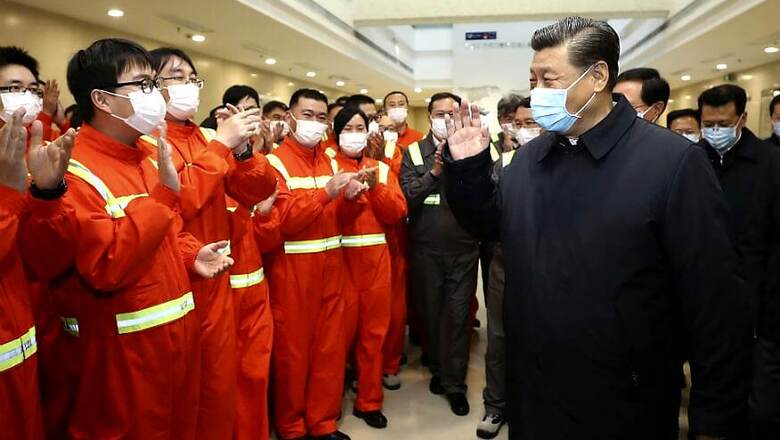
views
The novel coronavirus managed to spread to large parts of the world partly because China was not transparent about it till late January this year, even though the virus had been detected in early December last year. It has been reported that China suppressed doctors who tried to raise alarm against the virus. And yet, China is allegedly trying to rewrite history by running a disinformation campaign and projecting itself as the hero in the battle against the pandemic.
China will most likely succeed in its efforts, if history be taken as a cue. Many calamities and epidemics in history aggravated because of callous and insensitive attitude of rulers; yet these rulers have managed to evade the blame and project themselves as heroes.
More than half of the population of Odisha died in the Orissa Famine of 1866. The famine was preceded by a drought. Upon witnessing the drought, kings of garhjat provinces (princely states) and landlords requested the Divisional Commissioner Thomas Ravenshaw to provide some relief from the targets of land revenue collection given to them. Ravenshaw refused to waive the targets.
On the contrary, he refused to import rice when the Collectors of Balasore and Puri district raised serious alarm regarding the failure of crops. When people started dying of starvation, Ravenshaw tried to suppress the fact by writing misleading letters to the Board of Revenue at Calcutta. People petitioned the Lieutenant Governor, who turned a blind eye on being comforted by Ravenshaw.
Ravenshaw probably did this to maximise the tax collection for the Crown. Odisha had witnessed droughts in 1829 and 1841 too, but they had not led to famine. Such droughts generally triggered responsive measures from the administration. But it was different this time, due to Ravenshaw’s insensitivity.
But word soon got out and reached England that people were dying of starvation in the worst-ever famine to hit Orissa. A Famine Commission was constituted under Justice Campbell to investigate the mismanagement. Members of the Famine Commission reached Puri on December 17, 1866 and took witness depositions.
Most witnesses held Ravenshaw responsible for the famine. Babu Duryodhan Das, the deputy collector of Puri district, explained that 75% of the crops had failed in 1865, and people started dying of starvation as early as March 1866. The death toll grew exponentially subsequently. Rotting bodies catalysed a cholera outbreak, which aggravated the condition. In July, his staff had reported to him that a hungry man in the town of Kendrapada had eaten human flesh out of desperation.
But Ravenshaw refused to take any blame. He claimed that he was made to believe there was abundant grain in the state. On being confronted with reports of crop failure and scarcity sent by district collectors, Ravenshaw said he had formed an opinion on the basis of some sources, but did not recall these sources.
Ravenshaw also claimed that Oriyas were extremely apathetic and indolent, and did not try their best to collect food. THH Shortt, sub-divisional officer of Bhadrak, supported Ravenshaw’s claim by saying that Oriya natives are improvident and lazy.
The Lieutenant Governor (LG) was also evasive during his deposition. Earlier, during a field inspection, he had met distressed people who had told him that they were living on roots and jungle produce due to the famine. They had shown the roots and requested him to help. During deposition, the LG accepted that some people had shown him roots, but they were speaking in Oriya which he did not understand. So, he did not know what they were saying.
The Famine Commission submitted its report on April 6, 1867, in which it observed that Ravenshaw was unfit for the post of Commissioner. And yet, the British government retained him as Commissioner of Cuttack division for a substantial period of his remaining tenure in India.
Having been disgraced by the Famine Commission, Ravenshaw made conscious efforts to build his image. Few Oriyas had English education at the time. Few Oriyas had converted into Brahmo Samaj and were aping English customs. Together, they formed an elite class that worked closely with the administration. Ravenshaw patronised this elite group, who created a perception of Ravenshaw as a reformer and compassionate administrator. A college was opened in Ravenshaw’s name in Cuttack in 1868, when he was still the commissioner of Cuttack division.
People of Odisha today remember Ravenshaw as a reformer, although most have no clue about what reforms be brought.
Li Wenliang, a doctor who had tried to warn the authorities about coronavirus outbreak in Wuhan, died from contracting the virus on 7 February. He was one of the eight doctors who had been reprimanded for whistleblowing about the outbreak back in December 2019. His death triggered widespread public anger in China. China now calls these doctors ‘Eight Men of Virtue’. It is quite easy for a propaganda strategist to drown news reports on this incident in fake news content.
But a propaganda strategist ultimately needs to build a narrative to control how history will see the role of China in catalysing the worst pandemic of the century. China’s initiatives to reach out to other countries to help control the virus’ spread can act as fodder to build such a narrative.
(The writer is author of Loophole Games. Views are personal)


















Comments
0 comment